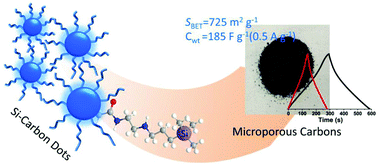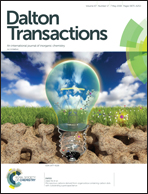Microporous carbons derived from organosilica-containing carbon dots with outstanding supercapacitance†
Abstract
In this study, a series of strongly luminescent organosilica-modified carbon dots were successfully synthesized in a scalable manner via hydrothermal treatment of citric acid and glucose in the presence of a silane coupling agent. Organosilica as a stable component coupled with the surface of carbons leads to the formation of gel-like materials. The obtained carbon dots can be homogeneously dispersed in various polar solvents such as water or ethanol to produce an optical solution. Importantly, the abundance of organosilica groups on the surface makes carbon dots ideally suited for use as fantastic carbon precursors for the construction of porous carbon materials. The carbons resulting from the pyrolysis of carbon dots consist of interconnected carbon nanoparticles with surface areas of up to 725 m2 g−1 and nitrogen content of 4.84%. Such carbons show potential application as supercapacitor electrodes with high specific capacitance of 185.4 F g−1 at 0.5 A g−1 and 176.3 F g−1 at 1 A g−1 in 6 mol L−1 KOH. Considered a relatively green and simplistic process, this current synthetic protocol would be a promising avenue to access functional carbon materials with tunable porosity, heteroatom doping and specific morphology.



 Please wait while we load your content...
Please wait while we load your content...